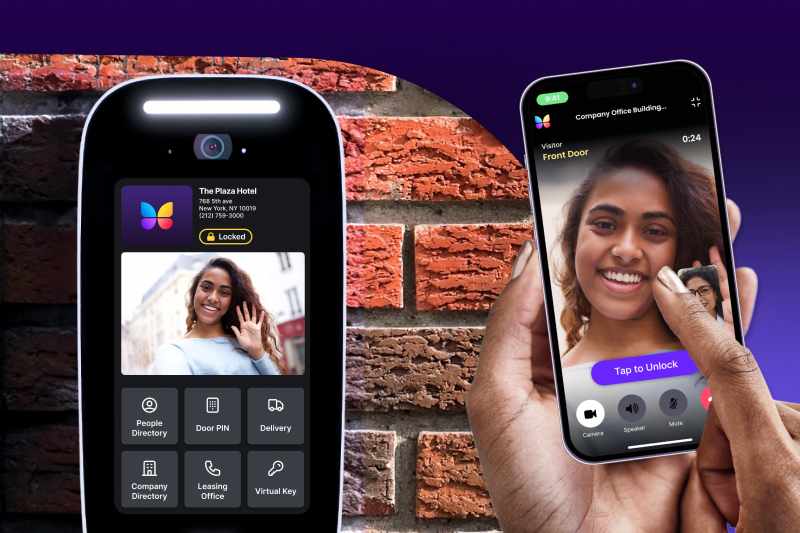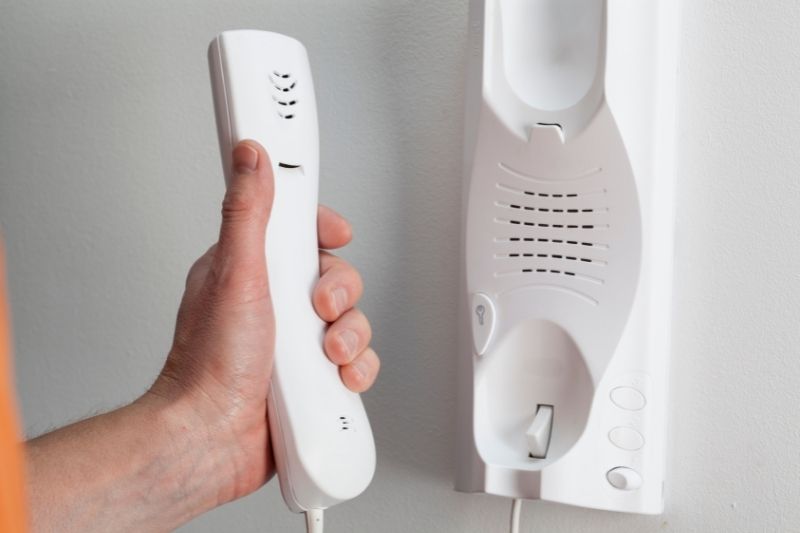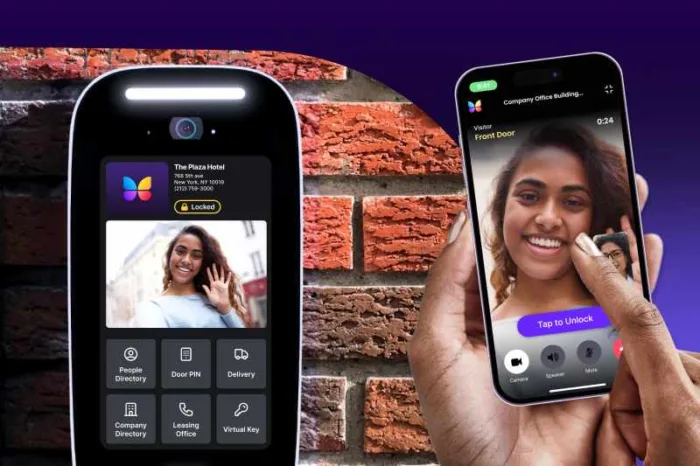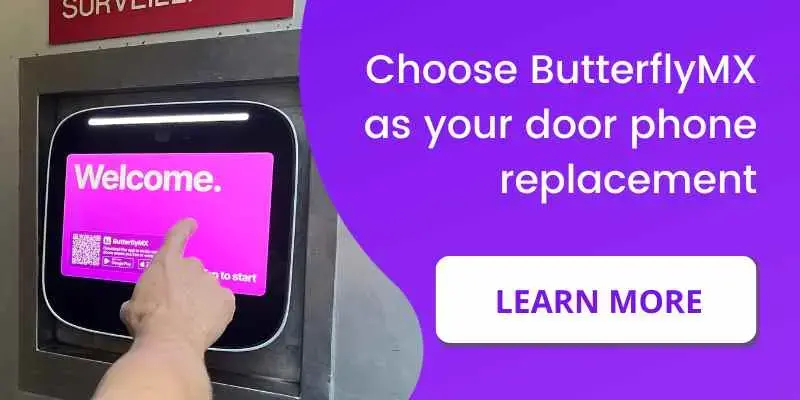Key takeaways:
- A door phone is a component of a door entry system, an electronic device that allows visitors and tenants to communicate and grant property access.
- There are three main types of doorbell phones: wired, wireless, and video.
- Despite having some good features, limitations of doorbell phones includes complicated and expensive hardware, no cloud-based software, no retrofit capabilities, and lack of robust security.

Every property type needs a way to monitor door entry activities and control who has door access. As a property owner, developer, or manager, you must ensure your building has a safe and reliable way to facilitate building access through the front door for tenants, guests, staff, and service providers. One commonly used door entry method is to install a door phone.
Most frequently installed in single-family homes, small offices, condos, and apartment buildings, door phones allow residents to speak with guests before granting them access. In this guide, we do a deep dive on doorbell phones, how they work, their shortcomings, and better alternatives you can choose.
Navigate this guide:
- What is the best alternative to door phones?
- Replacing your door entry phone system
- What is a door phone?
- Types of door phones
- How a door phone works
- Limitations of door phone systems
What is the best alternative to door phones?
The ButterflyMX video intercom system offers enhanced hardware and user-friendly software. Over 15,000+ customers have already installed ButterflyMX in their buildings. Simply put, the intuitive nature of this next-generation access control system is highly rated, state-of-the-art, and convenient.
More features of the ButterflyMX smart video intercom system include:
- Sleek design. The ButterflyMX IP video intercom has a 156° wide-angle camera that captures a broad picture of the surrounding area. Furthermore, it has an aesthetically pleasing design instantly increases your building’s curb appeal.
- Highly-rated mobile app. The part of the system tenants will use the most is the mobile app. Moreover, the ButterflyMX intercom makes it easy for tenants to use their phone app as a credential. Moreover, the intercoms are already equipped with WiFi.
- Integrations with other systems. The ButterflyMX intercom system easily integrates with a number of smart lock brands, which makes it easy for residents to control access from one app.
- Remote property management. The cloud-based ButterflyMX system simplifies property management. This means building staff can integrate their property management software with the intercom to streamline building administration processes.
Watch how ButterflyMX works:
Features of the best door phone alternatives
Doorbell phones might’ve gotten the job done at the turn of the century. But today, they don’t cut it anymore. Instead, IP video intercoms compete with today’s and tomorrow’s technological advances.
The top features to seek in IP video intercoms are:
- Transmission Control Protocol/Internet Protocol (TCP/IP) connectivities: IP video intercoms that use TCP/IP offer more complex features, such as digital access credentials to authorized guests.
- Highly-rated mobile app: The part of the system that tenants will use the most is the mobile app. So, make sure to choose a system that has an app with high ratings on the Apple and Google Play app stores.
- Integrations with other systems: The intercom operating system should integrate with other building automation systems, such as smart locks and thermostats. That way, residents can control all aspects of their apartment building from one app.
- Remote property management: Pick a cloud-based system to simplify property management. That way, building staff can integrate their property management software with the intercom to streamline building administration processes. With cloud-based systems, staff can monitor access control permissions and troubleshoot system bugs from anywhere.
Replace your door entry phone system with ButterflyMX
If you have a door phone system installed at your property, you’re long overdue for a replacement — try ButterflyMX instead.
ButterflyMX’s smart video intercom makes property access simple. With an easy-to-use mobile app and features that improve the access experience for residents and property staff, ButterflyMX beats out any doorbell phone system.
What is a door phone?
A door phone is the in-unit hardware component of a door entry system, an electronic device that facilitates communication and property access between visitors and tenants.
Also known as doorbell phones, door phones are placed inside individual apartment units. Typically, these devices are mounted on the wall and include buttons or a handset for tenants to listen and speak with guests at the building’s front entrance.
This in-unit device connects to outdoor hardware installed at the property entrance. Some systems operate on a telephone landline, while others transmit data wirelessly via the Internet. Newer systems also support video, allowing tenants to visually confirm visitors’ identities before letting them inside.
Components of a door phone system
Although there are various types of door phone systems, they all consist of three essential components:
- Outdoor station: The outdoor panel is installed near the front door or gate. Sometimes called an intercom doorbell, it includes a series of buttons, each button connecting to a specific unit’s doorbell phone. Additionally, the outdoor panel has a microphone and speaker.
- In-unit devices (phones): In-unit devices are the system’s actual “phone” component. They’re installed inside every unit within a property. Many door entry phones include wired telephone handsets. Tenants press either ‘9’ on the keypad or a designated ‘door open’ button to unlock the door remotely.
- Door release: You’ll need a door release mechanism with either an electric or magnetic lock so tenants can remotely open the door once they’ve granted visitors access.
Types of door phones
The term ‘door phone’ refers to various door entry phones, including wired and video options. In the past, doorbell phones exclusively meant in-unit landline telephone systems. But today, there are also wireless door entry phone solutions.
The three main types of door phone systems are:
Wired door phones
Wired systems require each in-unit device to be physically connected to the outdoor panel via telephone lines. Once a guest presses a button on the entry door phone intercom, that sends a signal to call the phone in the corresponding unit.
The biggest drawback of wired doorbell phones is that they’re one of the most expensive entry systems to install and maintain. And if one system component breaks, you may have to replace all the devices in every apartment unit.

Wireless doorbell phones
Wireless door phones, such as WiFi video doorbell phones, enable wireless connection via an Ethernet cable, cellular network, or Bluetooth. Today, connecting wireless door entry phones to the internet is most common. Also called IP door phones, wireless doorbell phones follow the Internet Protocol, which enables them to send signals via the Internet.
Since IP phone intercoms can transfer more data than wired systems, they often support video calls. Modern IP doorbell systems connect to tenants’ smartphones, allowing them to open the door or gate using their phones.
To provide more complex functionality, IP door entry phones use other internet-related protocols:
- Voice over Internet Protocol (VoIP): VoIP enables audio transfer between devices over the Internet. VoIP doorbell phones can transfer larger amounts of data than wired systems can.
- Session Initiation Protocol (SIP): SIP door phones work with VoIP technology to deliver video data and ensure that data syncs up with the system’s audio.
Video door phones
Video door phone systems operate with video calling, allowing tenants to see who’s at the door before opening it for them. The in-unit doorbell phone includes a screen to display video footage of visitors.
Modern video doorbell phone systems operate on VoIP and SIP to transfer audio and video data over the internet between visitors and tenants.
Wireless video doorbell phone systems may or may not include a physical, in-unit phone. While some do, the best systems replace in-unit hardware with tenants’ own smartphones. As a result, these IP video doorbell phone systems come with a mobile app that tenants can download on their smartphones, enabling them to answer visitor calls and remotely open the door from their phones.
How a door phone works
A doorbell phone facilitates audio-only or video calls between visitors and tenants in a commercial or multifamily building. If the system is a video door phone with an intercom, it supports video calls — which means tenants can see who’s requesting access.
Using the device installed at the entryway, visitors search for the tenant they’re visiting within the system’s directory. Then, the visitor presses the corresponding button, which rings the tenant’s in-unit entry phone.
Finally, the tenant answered the call on the doorbell and spoke with the visitor before granting them entry. If the in-unit device has a numeric keypad, the tenant presses ‘9’ to open the door or gate for the guest. Other doorbell phones will have a designated ‘door open’ button.
Limitations of door phone systems
At their core, door phone systems are synonymous with telephone entry systems. Although not all doorbell phone systems need to be connected to telephone lines, most still require extensive wiring throughout the entire building. But that’s not the only limitation of doorbell phones.
The four biggest limitations of door phone systems are that they:
- Require complicated and expensive hardware
- Don’t have cloud-based software
- Can’t be retrofitted for the modern-day
- Lack robust security and convenient features
1. They require complicated and expensive in-unit hardware
Door phones need to be mounted on the walls of each apartment unit. As a result, you must consider the cost of installing each device and the cost of carpentry when modifying the walls to run wires.
What’s worse, if the system breaks down, you’ll need to pay a professional to uninstall the devices from every unit and repair the walls.
2. The system isn’t cloud-based
Unlike newer IP door entry systems, traditional doorbell phones aren’t cloud-based. This means they can’t be managed remotely, and property staff must go on-site whenever the system needs to be repaired or updated.
3. They can’t be retrofitted for the modern-day
Because door phones are intensively wired throughout the building, you can’t simply update the system without ripping the whole ecosystem out of the building. At that point, it’s not worth updating a worn-out system. You should instead look for a better system altogether.
4. The system lacks robust security and convenient features
Although video door phones do support video calls, the video and audio quality isn’t up to par with the quality we’re used to on our smartphones. So, the door telephone phone system undoubtedly outdates itself and lacks robust security features like door entry audit trails.
Plus, doorbell phones don’t have convenient features like temporary access PINs that allow trusted guests to enter the property even if the resident isn’t home.








